#Albanian Architecture
Text

#albania#socialist albania#brutalist socialist#enverism#enver hoxha#albanian artists#socialist realism#museum#architecture#interiors#tirana's pyramid#red tirana#tirana
5 notes
·
View notes
Text



Lungro, Calabria, Italy
Lungro is one of the most prominent centers of the Arbëreshë people and the seat of the Eparchy of Lungro. This jurisdiction of the Catholic Church preserved the Byzantine rite and the local language, and encompasses all the Arbëreshë-speaking communities in the area.
The bell tower of Lungro's cathedral is covered with green, yellow and brown maiolica.
Follow us on Instagram, @calabria_mediterranea
#lungro#calabria#italy#italia#south italy#southern italy#italian#majolica#architecture#mediterranean#bell tower#church#europe#art#byzantine#eparchy#albanian#arbereshe
35 notes
·
View notes
Photo




Kuqi Mansion, Kruja/Albania
2 notes
·
View notes
Text
i've been working as a research assistant on a project looking at media depicting "warchitecture" in the yugoslav wars, chechnya and ukraine, and interpreting that as both historico-cultural semantics and as actual media. the project was inspired by and basically predicated on, the work of architectural philosopher/urban theorist andrew herscher, so i have a lot of the ideas from his work fresh in my mind. so with the ceasefire ending and israel's genocide continuing, i feel like it would be constructive to just share a bit from his book violence taking place: the architecture of the kosovo conflict.
herscher was working on his phd in the late-90s when the international criminal tribunal for the former yugoslavia (ICTY) asked him to join the prosecution and be an expert witness on the destruction of buildings during serbia's ethnic cleansing of kosovo 1998/99. and when working in the balkans collecting evidence and writing reports for the ICTY, he realised that relegating the destruction of architecture to an externality of violence was absent of the fact that the destruction and construction of architecture is a productive medium for expresing historico-cultural and political semantics -- invoking ideas of present and historical material conditions and realities, and enforcing them. in the case of kosovo, this was serbs ensuring the alterity of kosovar-albanians, projecting serbian orthodoxy over kosovar-albanian islam, destroying their communities to ensure they could not retain their autonomy, etc. one of the most common instances hersher encountered were the minarets of mosques being toppled, but the building left otherwise mostly intact. this is violence as performance, and as a means of engaging in a cultural discourse to marginalize and eliminate a community. it's a kind of violence which architecture reciprocates and reproduces meaning in.
attached a bunch of excerpts below. consider gaza and the experience of palestinians, and remember that the yugoslav wars ended with 161 political and military leaders being brought before a judge at the hague.




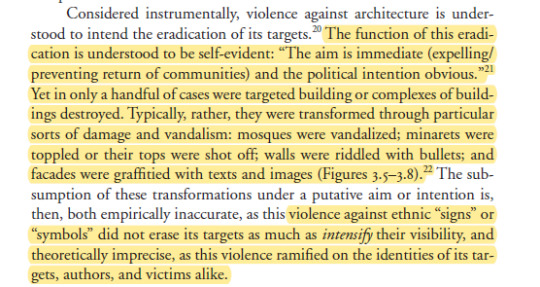
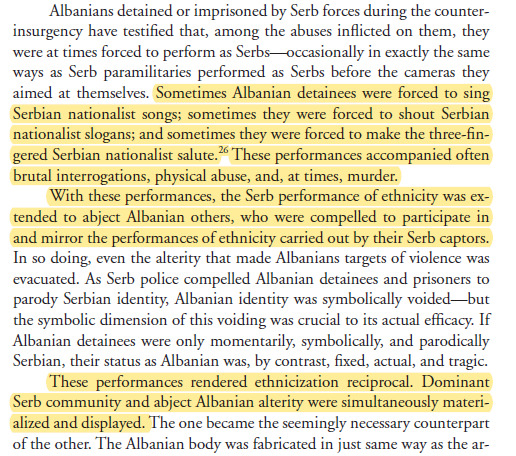

302 notes
·
View notes
Text
Serbia’s Minister of Construction, Transport and Infrastructure, Goran Vesic, has signed a contract with Affinity Global Development’s director Asher Abehsera on revitalizing the former Army General Headquarters in Belgrade, demolished by the NATO bombing of Yugoslavia in 1999.
Affinity Partners is Jared Kushner, former US president Donald Trump’s son-in-law’s, investment firm. It has $2 billion in funding from Saudi Arabia’s Public Investment Fund, among other foreign investors, media have reported.
“We are very excited,” the New York Times reported Kushner as saying in an interview in March about planned projects in Belgrade and Albania. “We have not finalized these deals, so they might not happen, but we have been working hard and are pretty close.”
The former military HQ is in the Belgrade city centre, right across from the gvernment building.
According to the ministry press release, Vesic said the government had leased the premises for 99 years but did not specify at what price.
“The investor has assumed the obligation that, if he does not complete the investment within the period specified in the contract, he will return the land and what will be built until then to the Republic of Serbia without compensation,” Vesic said after signing the deal on Wednesday*.
The press release said the investor will also be obliged to build a memorial complex “dedicated to all the victims of NATO aggression” from 1999 on the plot.
“The memorial complex will be financed by investors and will be owned by the Republic of Serbia, which will decide on the program content of the complex and will manage it,” Vesic said.
The design of the memorial complex will be determined at an international architectural competition.
Abehsera said the project includes a unique aspect of cooperation in which Serbian architects and designers will be invited to submit their ideas for the Memorial Centre.
Kushner previously confirmed plans on X (former Twitter) to invest in this complex as well as in two locations on the Albanian coast. The samer New York Times report in March said that Kushner been working on the Balkan deals with Richard Grenell, who served briefly as acting director of national intelligence under Trump and also ambassador to Germany and special envoy to the Balkans.
According to the NYT, the investment in Belgrade will be a luxury hotel and 1,500 residential units and a museum. It also reported that Trump himself had showed interest in working with this complex in 2013, but Kushner claimed he did not know about this.
The former Yugoslav army HQ was severely damaged in two 1999 NATO air attacks, beween April 29 and 30 and between May 7 and 8. Part of the premises were demolished between 2014 and 2017 for security reasons.
Information that a US company will take over the demolished HQ was first revealed by the Serbian opposition in March, drawing criticism because of suspicions of corruption but also because of the damaged HQ’s architectural and cultural value. It was claimed that the land on which the HQ lies was being leased free of charge.
The building was constructed in 1965 and designed by the famous Serbian architect Nikola Dobrovic.

9 notes
·
View notes
Text
strangers kissing

hello my sugars,
i began this summer in Rome. my goodness what a beautiful city. Italy itself was entirely romantic. subtract men from the equation and still my surroundings invoked an urge inside of me i never felt before.
what is it about location that changes the way you think so much?
i'm from a small town in the dessert, such a banal and exhausting destination for a woman whos heart contains puissance for vivacious activities, being surrounded by the grand ancient architecture, the walkable neighborhoods, and the lively streets were all someone like me could have ever dreamed of.
one night we stumbled into a private hookah bar, we had a few very strong drinks, i ordered a manhattan, something i've dreamed of doing since i was a little girl watching SATC, i did not enjoy it but it was pretty to look at.
we smoked from the hookah on a couch by the door, my goodness did we laugh in childlike wonder. who would've thought we could experience something like this? three best friends, listening to various languages, intoxicated by alcohol and joy at 3 a.m. in a foreign country.
soon some men (visually boyish) came and introduced themselves. I guess anyone in europe can seem boyish with the spectacular diet they have.
the boys were a year or two younger than us, strong Albanian accents, my friends were chatting with the tall one, and i caught the attention of the boy with glasses. my type.
we held hands as he sat in front of me, telling me about life in europe. the keyboard on his phone was so hard for me to understand while i punched in my instagram user.
we left the closing bar and he offered me his cigarette. the italian breeze blew in my hair and the cobblestone sang to my heels. i never had one before. he took a puff and passed it to me. we shared two cigarettes that night, foreshadowing the kiss we allotted just minutes after.
my time in Rome was quixotic. stunning outfits, tasteful cocktails, and the blissfulness of living like you'll die tomorrow. my heart is destined to leave the place i reside. i will experience the world, i have to.

#summer#rome#italy#romance#cigarette#bar#cocktail#blogging#blog#writeblogging#writers on tumblr#writeblr#dear diary#beauttiful girls#short story
3 notes
·
View notes
Photo

OODA @oodaarchitecture wins international competition for Klan TV Headquarters in #Tirana, Albania Read more: Link in bio! Visualization: Plomp @plo.mp. OODA’s design for Klan TV was selected as the winning proposal for the new headquarters of the historic and iconic Albanian TV station. Located in an area that is currently experiencing an exponential growth, the design draws inspiration from a set of film reels, local art and architectural features, vernacular and timeless. Standing next to the highway, the project aims to meet Klan TV’s expectations of becoming a free-standing icon in Tirana… #albania #archviz #архитектура www.amazingarchitecture.com ✔ A collection of the best contemporary architecture to inspire you. #design #architecture #amazingarchitecture #architect #arquitectura #luxury #realestate #life #cute #architettura #interiordesign #photooftheday #love #travel #construction #furniture #instagood #fashion #beautiful #archilovers #home #house #amazing #picoftheday #architecturephotography #معماری (at Tirana, Albania) https://www.instagram.com/p/CpjZR_nMkHv/?igshid=NGJjMDIxMWI=
#tirana#albania#archviz#архитектура#design#architecture#amazingarchitecture#architect#arquitectura#luxury#realestate#life#cute#architettura#interiordesign#photooftheday#love#travel#construction#furniture#instagood#fashion#beautiful#archilovers#home#house#amazing#picoftheday#architecturephotography#معماری
26 notes
·
View notes
Text
Chicken Bus Airplane
Excuse the exhaustion and the illiterate thoughts in this blog post, I believe I am at 30 hours without sleeping in a bed. if you can match the pictures to my stories, that would be helpful.
One of the strangest flights I’ve ever taken. If I took a charter bus from Charlotte, North Carolina to Madrid, I was on a school bus to Albania. People squished in, up in the aisles the entire flight, groups up and laughing and chatting with the flight attendants, window shades up, music playing, loud talking, people brought their own food on board, bananas, chicken, anything that smelled… school bus interior. As opposed to my charter bus interior plane that had pink lights to wake us up and light blue lights to dim the lights for sleep. Chatting, conversing, pushing and shoving, just to get on and off the plane. And at the airport, there were no announcements of boarding or gates. You just had to know where to go and when to get on the plane.
Long traffic jam drive back into the city to our hotel. Where we dropped our bags at the oldest hotel in Tirana and went looking for lunch. Ended up with Albanian stew, Albanian specialty soup, and Greek salad. (Photos) Very salty. Reminds me a lot of Romania. Actually the whole city reminds me a lot of Romania. Communist Era 1940s-1991. This dictator had his own brand of communism, and therefore Russia and Yugoslavia were the enemy.
Walking walking. Caroline and I take an online self guided walking tour of Tirana city. We ended up walking about 9 miles. Some great architectural buildings. (photos) Not the most beautiful city, still remnants of the communist era. We walked by what was once the communist dictator’s house. Enver Hoxha. As you can see from the pictures it is by no means a palace. Apparently he is so hated they closed the doors on his house and left everything inside and never looked back.
Pyramid. Apparently the dictator’s daughter built a pyramid mausoleum for her father. See photos. But he was so hated. He is no longer underneath the pyramid and now it is a tourist attraction that you can climb and see the city from above.
Doors… I swear every door is not closed, but they have this little lip on the door that’s about a half inch wide that makes it look like the door is not shut, but it’s really shut. See if you can tell what I’m talking about in the picture. It’s driving me bananas because I’m trying to slam the doors, but they are already slammed shut.
Walked to this man-made lake and had a rest and watched ducks and dogs play for a while.
Stray dogs. You can notice in a picture that one of the stray dogs we met has a blue tag on its ear. Similar to feral cats in Arizona, they round up the stray dogs vaccinate them, spay or neuter them, and if they can’t find a rescue to take the dogs, they release them back into the streets. But by seeing the tagged dog, you know it’s safe and healthy. The stray dogs seem to be very well fed.
Artist meeting. Walking along, we were looking for things that someone would normally not see. I looked down and saw an artist studio so of course we had to stick our noses in the door. Apparently this artist was very famous during communist times for his caricatures of the United States in Russia politically. Anyway we talked a while. Got some photos and went on our way. He was quite intense.
Professor meeting. As we were walking along the street, looking for coffee to give us energy a man walked up to us and said, “I am a professor. Could you tell me what the word squander means.”After a discussion about using it in context, he gave us a whole history of how dictators all are trained in France. And gave us many examples of how to use or how should he use the word squander. We finally said we had to go to the bathroom and left.
Me always looking for the spiritual salvation we went into the orthodox church and took some pictures and tomorrow will be the Great Mosque. It was cool to see this man touching up the murals on the inside of the Greek Orthodox Church
My Fluent Spanish. As one would predict my Spanish is very fluent in Albania. I’ve ordered Café con Leche, and at the restaurant said no Gatos no perros allowed. Albanians do not speak Spanish anymore than they speak English, but this is all that comes out of my mouth. As when I was in China, it’s always Spanish.
Dinner… delicious dinner in the touristy section of town. Near the castle. I had my favorite big fat sardines, big fat, feta cheese, and other appetizers. We shared a liter of wine and sat in the cool night patio.
Click on pictures to see the full view. 
In conclusion, I cannot believe how nice people are here. Everyone goes out of their way to help us. Instead of charging us a full amount they charge us less, take our phone and set up Wi-Fi, park a car, whatever that needs to be done to help. Our hotel is a wonderful, we can’t be happier, but we can’t be more exhausted.
- [ ]
2 notes
·
View notes
Note
Which one of your interests do you think you could go on the longest tangent about and why?
Oh, it's more like interest within an interest. Like a part of an interest and someone just mentioning it instantly sends me into a rant or a spiral.
From video game/fandom stuff:
Dishonored - literally anything about Dishonored, but mostly about Jindosh and his Clockwork Mansion. Legit can talk about it for hours.
Anything about Subnautica like at all
Darkin Lore, Aatrox, Kayn/Akali, Zed comic lore, old Viktor lore for League, they are huge hyperfixations
Ayleid, Clockwork City or Greymoor for ESO, I love the whole world of TES but these things can get me going for hours
Pirates of the Carribean, especially Davy Jones and Calypso, but good PotC meta gets me going
World of Warcraft - this is funny because once I was drunk at a New Years party and was telling my friend the entirety of WoW's lore. She didn't care but she was more drunk than me so she listened to me as if we are on a seminar. So like WoW lore in general, but probably anything Khadgar and "The Last Guardian".
And in general outside of video games
Films, like all kinds of films. I am a film major so I watch those 3 hour long Albanian indie film people make fun of (and yes they can be really good). Like anything film related. Also I am almost graduated in film editing so like editing related questions are within my realm.
Writing, especially character writing. My minor is in screenplay writing so I am kinda also obsessing over plays and screenplays and plot structure etc.
Horses. Horse girl at heart, used to ride for 4 years. Anything horse related is a go!
Gardening. I've gotten into gardening lately and it's such a relaxing thing to do, I recommend it to anyone that can get at least 2-3 flowers for their home.
Art/architecture history, like specifically fascinated by architecture history, even though I feel like I forgot a lot of what I learned 3-4 years ago.
2 notes
·
View notes
Photo

#albanian warriors#albania#albanian fustanella#fustanella#vernacular architecture#male accessories#long hair#mustache#full beard#ethnography#vintage#outlaws
1 note
·
View note
Text




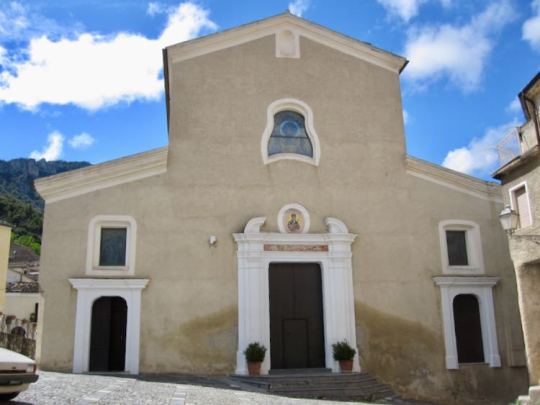
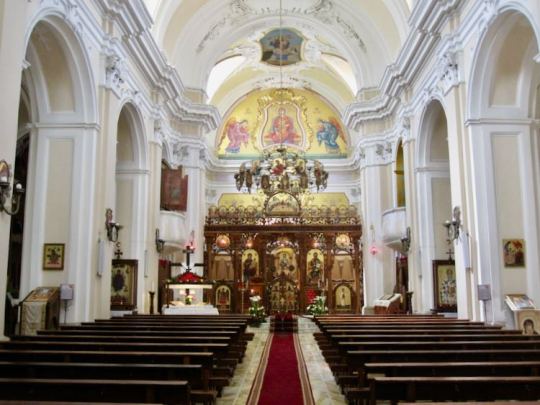


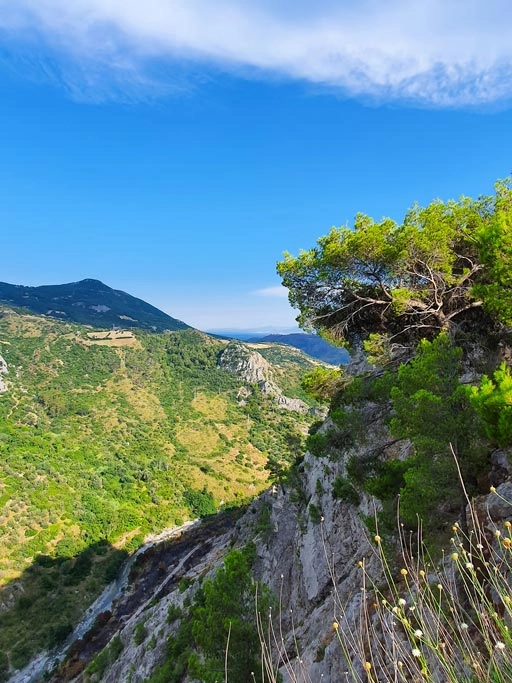
Civita, Calabria, Italy
Civita is hilltown town in Calabria in the heart of the Pollino National park, in Southern Italy's Calabria.
In Civita, Calabria, the history centers on an Albanian community fleeing from the Turks. While a precise arrival date is not known, the first Albanian explorers most likely came to the area in the 1470s. The “new” arrivals brought their language and culture with them, settling throughout the Pollino Mountains.
In keeping with Civita’s history, the local religion and village architecture reflect Arbëreshe culture. Just off the main piazza stands the Italian-Albanian Mother Church dedicated to Santa Maria Assunta. Its parishioners follow the Byzantine rite as part of the Eparchy of Lungro, an Italo-Albanian diocese in Calabria, subject to the Holy See. The Baroque structure features many elements of the Byzantine church, such as the beautiful iconostasis in walnut and olivewood, numerous icons and frescos.
Civita maintains its original layout, with neighborhoods of old two-story stone houses with large fireplaces situated along narrow lanes. Interestingly, the facades of several homes resemble faces, with a long chimney for the nose and windows for eyes.
The chimney stacks are another characteristic of the village, each unique design giving that personal touch to the habitation.
This village of fewer than 1,000 also boasts the dramatic natural setting of northern Calabria’s Pollino Mountains, part of Italy’s largest national park. One of Civita’s highlights is the Gole del Raganello, a deep canyon carved by the Raganello River, which flows to the Ionian Sea. From Civita’s enviable position of 450 meters (1,480 feet), views of the expansive river valley extend all the way to the sea!
From the oldtown, you can hike down the side of the canyon or take a jeep to the Ponte del Diavolo. This Devil’s Bridge has the familiar tale of having been constructed by the devil in exchange for the life of the first soul who crosses it. Being cleverer than the diavolo himself, the local landowner who made the pact with the devil tricked him by sending a sheep, instead of a person, over the new structure.
Photos by Un Trolley per Due and Calabria: The Other Italy
Follow us on Instagram, @calabria_mediterranea
#civita#calabria#italy#italia#south italy#southern italy#mediterranean#italian#europe#landscape#italian landscape#italian girls#italian girl#girl#girls#mountains#mountain#mountainscape#village#villages#italian landscapes#nature#nature photography#Arbëresh#albanian#chimney
22 notes
·
View notes
Text
Saimir Kristo: Architecture Is The Means To Create A Common Language Of Living
Weltraum, a radio podcast about space on the jabbering Independent Coastal Radio NOR hosted Saimir Kristo ... I had this great opportunity to talk about the city, his ideals and thoughts.

Saimir Kristo | Photo © Kristiana Meço
How Tirana changed in last 20 years?
Saimir Kristo: Talking about the weather it was much more rainy. It used to be the rainy city in Albania twenty years ago, when I come back from Greece. It changed radically. In 2004 there were not even proper bars. Of course nobody cared about the bars in that time, the country was just going out of a difficult period from the civil war in 1997, where pyramid schemes tricked citizens and took away their money. Fifteen years ago I am not really sure if we were not able to escape from this closed territorial system but today is the other problem, that people are leaving, there are massive emigrations. The problem I face as an individual but also as an architect in the last twenty years working in remote areas of Albania.
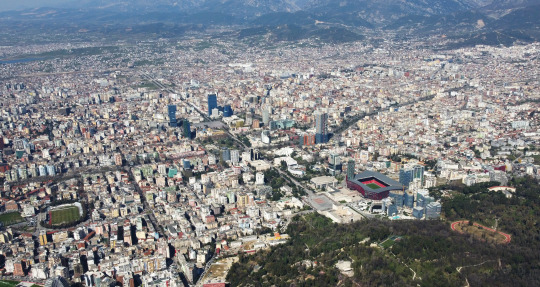
Tirana Aerial View | Photo © Open House Tirana
When I come back there was this amazing energy where people from Albania want to change the country, they wanted to go out from those enclaves from the past. There were many cases of informality in the 1990s, many cases of wild development, but there were people with the amazing energy. Whenever we have problems and we have the energy, we can always solve all problems because we have people around to solve it together. What about if you have depth and you go to the rural areas of Albania? Those villages were very much present in the landscape of the county but today are almost empty. Villages of once 1.000 inhabitants have now only thirteen people.
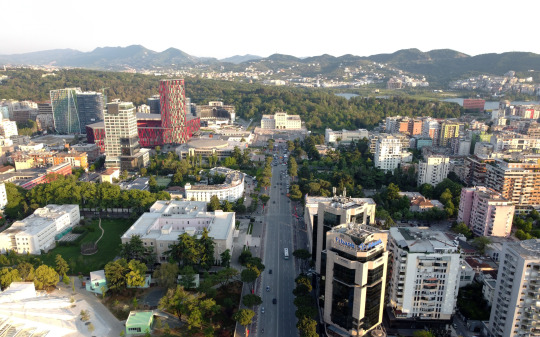
Tirana New Boulevard | Photo © Open House Tirana
The intention to move into big urban centres in the 1990s was very huge, it was a huge mass immigration. Today it's starting again. When I moved to Tirana there was just almost a half of a million people, reaching today a number of one million. So from 2,5 million Albanians that have left the county one million lives between Tirana and Durrës, the main port city. And we have 29.000 km2 of the territory. This is an important way to speak how Albania changed.
It is not always about architecture?
SK: I think is barely about the architecture. Architecture it is the means to justify, to camouflage, to improve and to manifest that people are much more sensitive about it. It is the means to deconstruct mentalities but also a means to educate to improve the settings and create a common language of living, of being. All these years of architecture in Albania, not as innovative approach because if was used in a part, is used in a way to transfer the identity of the city. I have a very famous image in mind, in 1990 when the main Skanderberg square had only pedestrians, only one bus and one truck.

Skanderbeg Square during daytime.| Photo © Open House Tirana

Skanderbeg Square changes it's identity during the evening.| Photo © Open House Tirana
Architecture is the means to justify, to camouflage, to improve and to manifest that people are much more sensitive about it. It is the means to deconstruct mentalities but also a means to educate to improve the settings and create a common language of living, of being.
People were thinking we had a very organised square with the right amount of people (whatever that means), a public transport with one bus. What if we go back to this situation? That can be very dangerous, because the Skanderberg square didn't had cars because people didn't want to use cars but because no one have a car easily. People also didn't feel the square as a public space but a main space for demonstration of the propaganda of the authoritarian regime of Hoxha. In the same way are the public spaces today, they might seem more contemporary organised but they are made only for events, either a political meeting, music concert or sports gather.
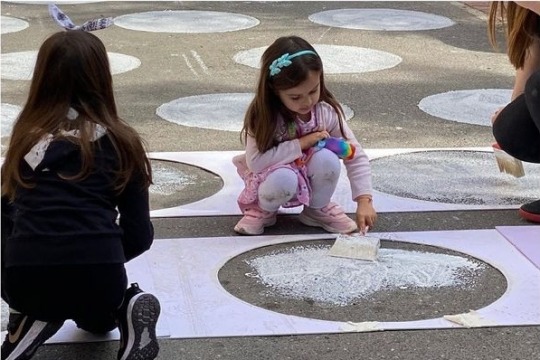
Urban Streetscapes: Filter Caffee Filtre | Photo © Tirana Architecture Triennial
The real life in squares makes them lively after midnight or early morning, where there is no urgency to be there but just a pure pleasure or desire. Architecture was and it still used to express political dominance and authority. To have a beautiful architecture we have to present it and experiment. I don't like the word educate, I think to have this relationship of co-ownership of projects that people really want.
The real life in squares makes them lively after midnight or early morning, where there is no urgency to be there but just a pure pleasure or desire.
As an educator you work in an educational institution, how is educational system about architecture in Albania functioning?
SK: It is situated on a dogma of the repetitive reproduction of something before, which is also linked to today, because students tend to limit their creativity because of the restrict educational system and their project doesn't resemble the project of their professors. This is a problem of us, educators. We have to change that. We continue to teach students what we were thought twenty, thirty years ago. We need to transform radically they way we do it. We shall focus on the importance of reading, going in depth of students ideas and expressions. Then students can find right tools to express better. We always try to copy what is present as innovative. It is on us, professors to educate ourselves more, read more and listen more. This is the the problem of architects, they don't listen so much but tend to speak.
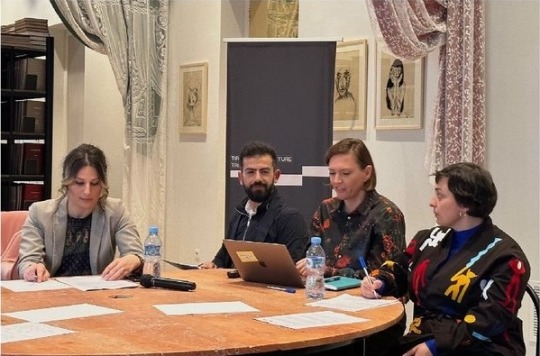
Roundtable Virtual or Physical; from left to right Etleva Dobjani, Saimir Kristo, Dijana Vučinić, Tinatin Gurgenize. | Photo © Tirana Architecture Triennial
The other topic, which I am very critical about, is the issue of non payed work. This has became a standard. We teach students to be aware of how much they need to be payed to be able to value their work. These are things that were never talked before in the auditorium.
Maybe LINA is the good opportunity for that; what did LINA created for Bartleti?
SK: Some of our LINA fellows presented the issue of inclusivity and education, which makes me very proud of. For Bartleti LINA collaboration makes a very important presence for bringing fresh ideas from incredible fellows with a high level of integrity and professionalism. On the other side this enhanced courage to our students to work with these topics and collaborate with the others. It is a case of asking question in a classroom and feeling a prejudice why are you asking this question. If you see other people having the same question, the you are part of the community. The other important issue is a continuous collaboration with other institutions that are part of LINA. I always have called this more that European union of architecture, because it extends beyond Europe.

Space Saloon + The MAAK | Photo © Tirana Architecture Triennial
International collaboration can not only be used as a mean to justify but can also be used as a means to go further, to look beyond and investigate a very delicate problem. Last year we had an opportunity to host New South with the issue of Sacred grounds.

Sacred Grounds by New South. | Photo © Tirana Architecture Triennial
We have this phenomenon of reduced co-existance in Albania. We have four different religions, which all cohabitate together. This is because our dictator abroad the religion in the 1960s, so when there was no religion, they need to find a common language to keep their faith inside them. In the New South's installation in the National historic museum, the most dictatorial building in Albania, presented all these four religion and in such way created a non physical temple for people of all these four religions inside an extra dogmatic building. We try to touch not only the build aspect but also how we perceive the space.
What kind of act is the demolishment of the National Theatre of Albania that happened few years ago?
SK: The demolition of the National Theatre was a collective act. It was not just an act to build a new theatre. It is not only an act by the government to transform a public space, get read of the old building or neglect it' s value. I think it's an act of us as architects, us as citizens of Tirana, not to raise the attention to all other historical buildings that have been left to the mercy of time since thirty years now. It is something we need to reflect in our consciousness. We might not have the money to restore the building, as culture is the smallest portfolio in our government. We have to ask for more. Demolitions is not something sporadic, that happened with the theatre, this is happening with hundred of historical buildings in Tirana and all around Albania. (Saimir presented the Forgotten Masterpieces of Albania in some of our previous talks).
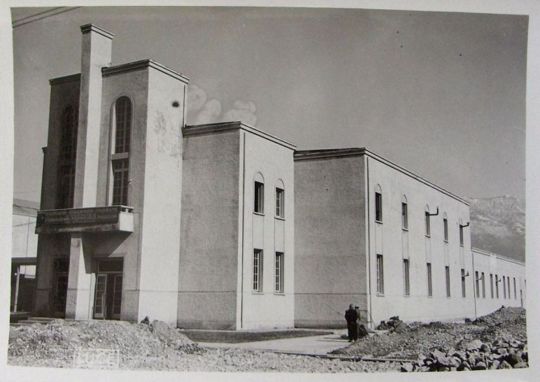
The National Theatre in Tirana. | Photo via Architectuul
We are always there in the last moment, when we know that there is one percent of chance to save it. We should emphasise the importance of thesis buildings and find a way to restore them. The city from twenty years ago it's not recognisable today. This is telling a lot about us, because to rebuild and restore takes a lot more time to discuss and work on that. In many levels the case of theatre is a consume story but it's also an inflation of our society and at the end you have one more building less to admire. The 17th of May 2020 at 4:30 in the morning, that's when the theatre collapsed, should not be the moment to ask the old theatre to be rebuild again in the place of the old one, but should be a moment to commemorate how neglected we were as a society and how important is to turn the attention on the city that we are taking advantage of.

Northern Boulevard Extension | Photo © Open House Tirana
The memory of the city is always important and we need to be able to pass over the memory of the story of the historical theatre to the next generations and not to romanticise the idilic idea of a new theatre by BIG. It is important of how to show the identity of our city.
How do you see architecture in the future?
SK: Beautiful! Why not! I am not part of the dramatic and pessimist discussions that architecture and our cities are getting worse. We have students that are not compromising themselves and they want to do a change. I want to Wellcome all the changes to see myself as a part of this evolving system. With new students working in the field of architecture we just have a bright future. What we need is to embrace all these things to feel them. We have to open our minds and to wake up. We have to keep the dream of our inner small Chile inside and working in architectural education we are responsible to keep that dream of all these young students alive and we have to foster it.

The National Theatre of Albania was demolished on 17. May 2020 at 4am. | Photo © Saimir Kristo
Saimir Kristo, P.hD. is an architect and urban designer, currently Deputy Dean and Lecturer at the Faculty of Applied Sciences and Creative Industries at BARLETI University. Founder of Tirana Architecture Triennale - Architecture Fund in Albania and Open House Tirana. He is an APLS Alumnus invited by the Austrian Ministry of Foreign Affairs and IVLP Alumnus invited by the US State Department representing civil society in Albania. As an active member of civil society, he is engaging communities to develop a common educational platform in the field of architecture and urban planning. His professional practice IXI Architecture is working in tangible and intangible mediums to transform urban design and architecture in Albania for the better. He holds a Ph.D. in Architecture and Urban Planning Focused on city morphology and urban catalysis and their role in the transformation of public spaces, a research result of his experience as a project leader in Urban Regulatory Plans in Albania. His scientific activity extends with monographs and publications but also as a jury member in international competitions. He serves as the Independent Nominator for the “EU Mies van der Rohe Award” appointed by the Fundacio Mies van der Rohe for Albania. Since its establishment, he has been a board member of "Fundjavë Ndryshe" foundation.
Here You can listen to the WELTRAUM interview.

2 notes
·
View notes
Text
Here's a timeline of Serbian history with key details:
- 7th century: The Slavs settle in the Balkan Peninsula, laying the foundation for the Serbian people's emergence.
- 9th century: The Serbian state begins to form under the leadership of Vlastimir, marking the early stages of Serbian statehood.
- 10th century: The medieval Serbian state is established, with the Nemanjić dynasty becoming prominent rulers.
- 1166: Stefan Nemanja founds the Serbian Orthodox Church and becomes the Grand Župan (prince) of Serbia.
- 1346: The Serbian Empire, led by Stefan Dušan, reaches its zenith, encompassing much of the Balkans.
The Serbian Empire in 1346, also known as the Empire of Stefan Dušan, was a medieval Serbian state that reached its zenith under the rule of Stefan Dušan, a remarkable Serbian monarch. Here are some key details about the Serbian Empire at that time:
**1. Stefan Dušan's Ascension:** Stefan Dušan, also known as Dušan the Mighty, became the ruler of Serbia in 1331 as the King of Serbia, succeeding his father, Stefan Dečanski. He expanded his authority over various regions, including parts of modern-day Serbia, Montenegro, Macedonia, and Greece.
**2. Coronation as Emperor:** In 1346, Stefan Dušan elevated his status to that of Emperor, adopting the title "Emperor of Serbs and Greeks." This move signified his ambition to establish a multi-ethnic and multi-religious empire.
**3. Territorial Expansion:** Under Dušan's rule, the Serbian Empire expanded significantly. It reached its territorial peak, encompassing a vast area of southeastern Europe. His conquests included regions inhabited by Serbs, Greeks, Albanians, and Bulgarians.
**4. Legal and Administrative Reforms:** Dušan implemented a legal code known as the "Dušan's Code" or "Dušan's Law," which was a comprehensive set of laws and regulations. It aimed to create a unified legal framework for his diverse subjects and to consolidate his rule.
**5. Religious Policy:** Despite the empire's religious diversity, Dušan supported the Serbian Orthodox Church and worked to strengthen its influence. He saw himself as the protector of Orthodoxy and sought to establish the Serbian Patriarchate under his rule.
**6. Cultural Flourishing:** The Serbian Empire under Stefan Dušan saw a flourishing of culture, art, and architecture. Notably, he commissioned the construction of the Monastery of the Holy Archangels in Prizren, which remains a significant cultural and historical site.
**7. Decline and Succession:** Despite its initial success, the Serbian Empire faced internal and external challenges. Stefan Dušan died in 1355, and his empire began to weaken due to internal conflicts and external pressures from the Ottoman Turks and other neighboring powers.
**8. Fragmentation:** After Dušan's death, the empire fragmented into smaller states and principalities, including the Serbian Despotate, which continued to exist for several decades. The Ottoman Turks gradually expanded their influence in the region, eventually leading to the fall of Serbian medieval states to Ottoman rule in the late 14th and early 15th centuries.
In summary, the Serbian Empire of 1346, led by Stefan Dušan, represented a brief but significant period in Serbian history when the country reached the height of its territorial and political influence. Dušan's ambitious rule left a lasting impact on the region's history and culture, even though the empire's decline was inevitable in the face of external threats and internal divisions.
- 1389: The Battle of Kosovo takes place, with Serbian forces led by Prince Lazar facing the Ottoman Empire. Though a tactical draw, it marks the beginning of Ottoman dominance in the region.
- 15th-19th centuries: Serbia remains under Ottoman rule, enduring centuries of struggle for independence.
- 1804: The First Serbian Uprising against the Ottoman Empire begins, eventually leading to autonomy for Serbia.
- 1835: The Convention of Akkerman grants Serbia expanded autonomy under Ottoman suzerainty.
- 1878: The Congress of Berlin recognizes Serbia as an independent nation, free from Ottoman control.
- 1914: The assassination of Archduke Franz Ferdinand of Austria-Hungary in Sarajevo triggers World War I, during which Serbia faces significant hardships.
- 1918: The Kingdom of Serbs, Croats, and Slovenes (later Yugoslavia) is formed, uniting South Slavic peoples under King Alexander I.
- 1941-1945: Yugoslavia is occupied by Axis powers during World War II, leading to the formation of the Yugoslav Partisans resistance movement.
- 1945: Yugoslavia becomes a socialist federation under Marshal Tito's leadership.
- 1991: The disintegration of Yugoslavia begins with the secession of Slovenia and Croatia.
- 1999: NATO intervenes in Kosovo, a province of Serbia, leading to the end of hostilities in the Kosovo War.
- 2003: The Federal Republic of Yugoslavia transforms into the State Union of Serbia and Montenegro.
- 2006: Montenegro holds a referendum and gains independence, leaving Serbia as the successor state.
- 2008: Kosovo unilaterally declares independence from Serbia, which Serbia does not recognize.
- 2019: Aleksandar Vučić is elected as Serbia's president, continuing his leadership.
This timeline offers a snapshot of Serbia's complex history, marked by periods of independence, Ottoman rule, socialist federation, and the challenges of the breakup of Yugoslavia in the late 20th century. Serbia remains a key player in the Balkan region today.
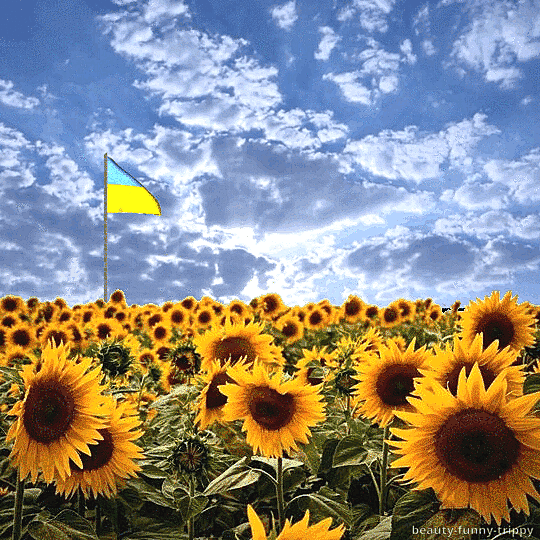
5 notes
·
View notes
Photo

Pristina national library, Pristina, Kosovo
Designing Libraries | 2. The architecture of libraries is intensely political. The bigger and grander the library, the more powerful its city or region appears to be, which is why ambitious rulers and plutocrats have spent so lavishly on them. For the same reason, the symbolism of library architecture is equally powerful, as the story of the National Library of Kosovo illustrates.
.
It was commissioned in the early 1970s, when Kosovo was part of Yugoslavia, one of Eastern Europe's most progressive communist-controlled countries under its president Josip Broz, known as Tito. The architect, Andrija Mutnjaković, was charged with designing a new building to house important collections of books and manuscripts held in the region since the 14th century on a site near Pristina, now Kosovo’s capital.
.
Mutnjaković seized the opportunity to design a library that combined modernist references (a nod to Tito’s vision of Yugoslavia) with the influence of Byzantine and Islamic architecture on Kosovo, and the rural nature of the region. The result was a strikingly idiosyncratic building topped by 99 translucent acrylic domes of different sizes covered with metal netting. When it opened in 1982, two years after Tito’s death, the library’s design was both fiercely criticised and hailed as a model of Metabolism. Its diverse influences - such as the domes that allude to both a national Albanian hat and the roof of the nearby 14th century Serbian-Orthodox Gračanica Monastery - made it a contentious symbol in the growing tension between Kosovo’s Albanian majority and Serbian-controlled Yugoslavia.
.
During the Yugoslav Wars in the 1990s, the library provided shelter for refugees who’d fled from Croatia and Bosnia-Herzegovina, while serving as a control centre for the Yugoslav Army, which caused grave structural damage while destroying the reading room furniture and pulping over 100,000 Albanian language books. After the wars, repairing and restoring the library was a priority for Kosovo.
.
Images: 1. (© Manifesta 14/Atdhe Mulla); 2. (© Arben Llapashtica/Creative Commons)
2 notes
·
View notes
Text
Discover the Hidden Gem of Europe Traveling to Albania 🌍✨

Are you ready to embark on a European adventure that’s off the beaten path? Let me introduce you to Albania, a stunning destination filled with breathtaking landscapes, rich history, and vibrant culture. Here’s everything you need to know before you go!
Why Visit Albania? 🇦🇱
Albania may not be on everyone’s travel radar, but this hidden gem offers a unique blend of Mediterranean charm and Balkan warmth. From the beautiful beaches along the Albanian Riviera to the historic streets of Tirana, Albania has something for everyone.
Best Time to Go ⏰
Plan your trip in spring (April to June) or early autumn (September to October) for the best weather and fewer crowds. If you’re dreaming of sun-soaked beaches, July and August are the peak months, perfect for a seaside getaway!
Must-See Destinations 🗺️
Tirana: Experience the vibrant street life and colorful buildings of the capital.
Berat: Explore this UNESCO World Heritage Site known for its stunning Ottoman architecture.
Saranda: Relax on beautiful beaches and visit the ancient ruins of Butrint.
Gjirokastër: Discover the historic castle and charming stone houses in another UNESCO gem.
Safety and Cuisine 🍽️
Albania is a safe destination for tourists, and you’ll be welcomed with open arms by the locals. Don’t miss out on trying traditional dishes like byrek and tavë kosi—your taste buds will thank you!
Getting Around 🚍
With options like buses, taxis, and rental cars, getting around Albania is easy and affordable. If you’re joining a Europe tour package, check if transportation is included for added convenience.
Pack Smart! 🎒
Bring comfortable clothing, good walking shoes, and don’t forget your sunscreen! The stunning scenery and local experiences will leave you in awe.
Ready to add Albania to your Europe tour packages? Let the adventure begin! 🗺️💖
0 notes
Text
Explore the Hidden Gems: Unforgettable Tours in Albania

Escape the ordinary and embark on a journey to discover the hidden gems of Albania. This mesmerizing country is often overlooked by travelers, but it holds a treasure trove of unforgettable tours in Albania and experiences that will leave you in awe. From the pristine beaches of the Albanian Riviera to the rugged mountain landscapes of the Accursed Mountains, Albania offers a unique blend of natural beauty and rich history.
Immerse yourself in the vibrant culture of Tirana, the capital city, or marvel at the ancient ruins of Butrint, a UNESCO World Heritage Site. Explore the charming Ottoman-era towns of Gjirokastra and Berat, known for their well-preserved architecture and stunning views. For adventure seekers, hiking in the Albanian Alps or exploring the underground wonders of the Blue Eye Spring is a must.
Whether you're a nature lover, history enthusiast, or simply looking for an off-the-beaten-path destination, Albania has it all. Unravel its secrets and create memories that will last a lifetime on one of the unforgettable tours that this enchanting country has to offer.
Unique Attractions in Albania
Albania, a country with a wealth of unique attractions, offers a blend of natural beauty, historical sites, and architectural marvels that are distinctively its own. Among these, the town of Krujë stands out, nestled in the mountains and home to the National Museum of Skanderbeg, the 15th-century hero who fought against the Ottomans. This museum, located within Krujë Castle, provides a deep dive into Albania’s struggle for independence and offers panoramic views that are simply breathtaking. The old bazaar, located just outside the castle, is a treasure trove of antiques, traditional crafts, and souvenirs, making it a perfect spot for visitors looking to take a piece of Albania home with them.
Another unique attraction is the Pyramid of Tirana, originally designed as a museum to honor the dictator Enver Hoxha. Despite its controversial past, the pyramid has become a symbol of Albania’s complex history and transformation. Today, it serves as a canvas for graffiti artists and a playground for adventurous urban explorers, embodying the country’s progress from its totalitarian regime to a burgeoning democracy. Plans to transform the site into a cultural center indicate the pyramid’s evolving significance in Albania’s narrative.
Lastly, the Bektashi World Center, located in Tirana, offers a fascinating glimpse into the mystical world of Sufism in Albania. The Bektashi order, a Sufi Islamic sect, is known for its tolerance and openness. Visitors can explore the grand complex, learn about the Bektashi traditions and beliefs, and enjoy the serene atmosphere that pervades this spiritual site. The center’s architecture, with its symbolic elements and intricate details, reflects the depth and richness of Bektashi culture.
Historical and Cultural Tours in Albania
Albania’s tapestry of history and culture is vividly displayed through its numerous historical sites and cultural experiences. The ancient city of Butrint, a UNESCO World Heritage Site, offers a journey back in time through its well-preserved ruins, which span several civilizations, including Greek, Roman, Byzantine, and Venetian. Guided tours through this archaeological marvel reveal stories of ancient life and the strategic importance of Butrint through the ages. The site’s natural setting, surrounded by a tranquil lagoon, adds to its mystical charm and allure.
In the heart of Albania, the cities of Berat and Gjirokastra, both recognized as UNESCO World Heritage Sites for their outstanding Ottoman-era architecture, beckon visitors to explore their historic paths. Berat, known as the “City of a Thousand Windows,” fascinates with its unique architecture, where houses seem to stack upon one another on the city’s hillsides. Gjirokastra, with its formidable castle overlooking stone-roofed houses that climb up the mountainside, offers a glimpse into the country’s medieval past. Cultural tours in these cities are incomplete without visiting their historic mosques, churches, and museums, which provide insight into the rich cultural tapestry of Albania.
Moreover, the National Historical Museum in Tirana serves as a gateway to understanding Albania’s journey through time. The museum’s exhibits cover the span of Albanian history, from ancient times to the post-communist era, highlighting the country’s archaeological treasures, struggle for independence, communist oppression, and the road to democracy. The museum's facade, adorned with a gigantic mosaic titled “The Albanians,” symbolizes the nation’s resilience and pride.
Adventure and Outdoor Tours in Albania
For those with a spirit for adventure, Albania’s rugged landscapes and pristine natural wonders offer a playground unlike any other. The Albanian Alps, also known as the Accursed Mountains, provide some of the most breathtaking hiking trails in Europe. The Valbona to Theth hike, a part of the Peaks of the Balkans trail, is particularly renowned for its stunning scenery, challenging terrain, and the warmth of the local guesthouses where hikers can rest and recharge. This trek not only tests the endurance of its adventurers but also rewards them with unparalleled views of Albania’s untouched natural beauty.
The adventure continues underground with the mesmerizing Blue Eye Spring (Syri i Kaltër), a natural water spring known for its hypnotic blue color and mysterious depths. Located near the city of Saranda, guided tours offer the chance to explore the surrounding area, which is a haven of biodiversity. While swimming is not allowed in the spring itself, the site provides a tranquil setting for relaxation and contemplation amidst nature’s marvels.
For those seeking a blend of adventure and history, the Llogara Pass offers a thrilling drive through one of Albania’s most scenic routes, winding through the Ceraunian Mountains towards the Ionian Sea. The pass provides breathtaking views of the coast and is a gateway to exploring the untouched beaches and charming villages of the Albanian Riviera. Paragliding off the Llogara Pass is an option for the truly daring, offering a bird’s eye view of this spectacular landscape.
Culinary and Wine Tours in Albania
Albania’s culinary scene is a delightful surprise to many, characterized by its Mediterranean flavors, fresh ingredients, and unique regional dishes. Culinary tours in Albania offer a taste of the country’s rich gastronomic heritage, where olives, cheeses, fresh seafood, and organic fruits and vegetables play starring roles. A visit to a traditional Albanian farm can provide insight into the country’s agricultural practices and an opportunity to taste homemade products like rakia, a potent fruit brandy, and byrek, a savory pastry.
Wine connoisseurs will find Albania’s burgeoning wine industry a hidden gem. The country’s wine history dates back thousands of years, and recent efforts have revived ancient grape varieties and winemaking traditions. Wine tours typically include visits to local vineyards and cellars, especially in regions like Berat and Korçë, where visitors can learn about the winemaking process and indulge in tastings of indigenous varieties such as Shesh and Kallmet. These tours not only offer a glimpse into Albania’s wine culture but also showcase the hospitality and warmth of its people.
Furthermore, the coastal city of Durrës, with its rich history and vibrant culinary scene, is a must-visit for seafood lovers. Traditional restaurants along the coast serve dishes brimming with the freshest catch of the day, perfectly paired with local wines. Culinary tours in Durrës often include cooking classes where guests can learn to prepare classic Albanian seafood dishes, blending centuries-old traditions with the flavors of the Ionian and Adriatic seas.
Beach and Coastal Tours in Albania
Albania’s coastline, with its stunning beaches and crystal-clear waters, is one of the country’s most enticing features. The Albanian Riviera, stretching from the Llogara Pass to Ksamil, is dotted with idyllic beaches such as Dhërmi and Jale, known for their azure waters and vibrant nightlife. Coastal tours in this region offer opportunities for sunbathing, swimming, and enjoying the laid-back Mediterranean lifestyle. Excursions to the more secluded beaches, accessible only by boat, provide a sense of adventure and exclusivity.
Ksamil, near the Greek border, is famed for its breathtaking beauty and tranquil islands, which can be easily reached by a short swim or boat ride. The area is also known for its delicious seafood, with local restaurants serving dishes made from the day’s catch. Beach tours in Ksamil often include water sports such as jet skiing and snorkeling, allowing visitors to explore the rich marine life of the Ionian Sea.
Lastly, the Lagoon of Narta, near the city of Vlorë, offers a different coastal experience, with its vast salt pans and diverse birdlife, including flamingos and pelicans. Guided tours of the lagoon provide insight into Albania’s natural ecosystems and the importance of conservation efforts. The nearby Zvërnec Island, with its ancient Byzantine monastery, adds a historical dimension to the beauty of Albania’s coastline, creating a perfect blend of nature, history, and tranquility.
Albania, with its unique attractions, historical and cultural richness, adventurous landscapes, culinary delights, and stunning coastline, is a destination waiting to be explored. Unforgettable tours across the country reveal the hidden gems of Albania, offering experiences that cater to every type of traveler. From the peaks of its mountains to the depths of its seas, Albania’s treasures are as diverse as they are captivating, promising memories that will last a lifetime.
0 notes